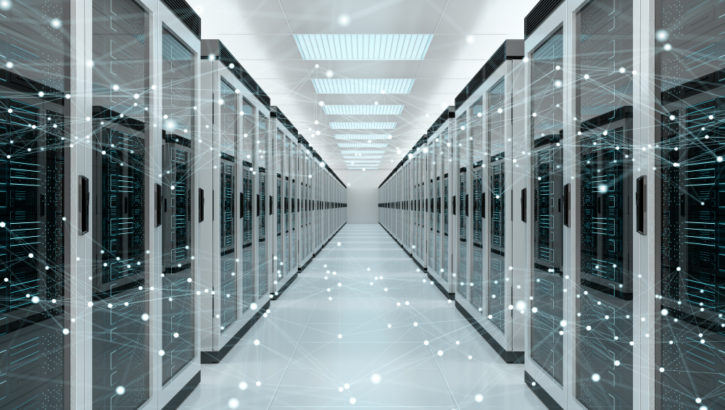
(Sdecoret/Shutterstock)
The center of gravity in high performance computing continues to shift, with power emerging as the defining constraint for growth and scale. Training and deploying frontier AI models now demand physical infrastructure at levels once reserved for heavy industry. A single 1 gigawatt facility can draw as much power as one million U.S. homes. What once seemed excessive has quickly become the new baseline — and the leading tech firms are aiming far beyond it.
On Tuesday, OpenAI announced five new data center sites across the United States in partnership with Oracle and SoftBank. The new builds are part of the company’s Stargate initiative, which now targets 7 gigawatts of capacity and a full scale-out to 10 by the end of 2025. Total investment is expected to reach 500 billion dollars. Construction is already underway in Ohio, Texas, and New Mexico, with one site still undisclosed. Together, these facilities form the backbone of what may become the largest AI-focused infrastructure project in the country.
Three of the new data centers will be built with Oracle. Those sites include one in Shackelford County, Texas, another in Doña Ana County, New Mexico, and a third at a still-undisclosed location somewhere in the Midwest. The other two, located in Lordstown, Ohio and Milam County, Texas, are being developed with SoftBank. That group has committed to a fast-build approach meant to scale quickly to multiple gigawatts. All five locations were selected earlier this year, after a nationwide search that drew hundreds of proposals from over thirty states.

(Gorodenkoff/Shutterstock)
When these new facilities are added up, the Stargate pipeline moves to seven gigawatts. The long-term goal is ten, with total investment expected to reach five hundred billion dollars by the end of next year. Construction has already started in several of the regions. In Abilene, where the project is furthest along, a crew of more than six thousand workers has already been on site. The amount of fiber installed so far is enough to circle the planet many times over. The numbers make it clear: this is no longer just a story about data. It is a full-scale industrial buildout, one that reshapes how AI infrastructure is going to be built in the United States.
“AI is different from the internet in a lot of ways, but one of them is just how much infrastructure it takes,” OpenAI CEO Sam Altman said during a press briefing in Abilene, Texas, on Tuesday. He argued that the US “cannot fall behind on this” and the “innovative spirit” of Texas provides a model for how to scale “bigger, faster, cheaper, better.”
The announcement also served as a subtle rebuttal to critics who had questioned whether the Stargate project would move from concept to execution. Altman’s comments come as rival firms race to secure their own AI infrastructure pipelines. Meta is pursuing multi-gigawatt campuses under project names like Prometheus and Hyperion. Microsoft and Amazon are fast-tracking new sites in Louisiana, Wisconsin, and Oregon. Across the board, the line between cloud and compute infrastructure has blurred.
OpenAI has aligned compute demand, financial backing, and physical deployment under one program. Oracle is providing the cloud substrate. SoftBank is delivering fast-build facilities. Microsoft and NVIDIA remain key suppliers. If the execution holds, Stargate may set a new benchmark for what AI-scale infrastructure looks like in practice.
“We cannot fall behind in the need to put the infrastructure together to make this revolution happen,” said Altman during a Q&A with reporters. “What you saw today is just like a small fraction of what this site will eventually be, and this site is just a small fraction or building, and all of that will still not be enough to serve even the demand of ChatGPT,” he said, referring to OpenAI’s flagship AI product.

(kovop/Shutterstock)
There’s no question that a project of this scale brings real challenges. Building out multi-gigawatt capacity takes more than land and capital. It requires electricity on a level that most regional grids are not prepared to handle. Supplying that power means working with utilities, navigating local permitting processes, and dealing with infrastructure that was never designed for this kind of load.
Several of the planned Stargate sites will need new substations, upgraded transmission lines, and large-scale cooling just to stay on schedule. The pace is fast, and even for seasoned players like Oracle and SoftBank, keeping momentum will not be easy.
Previously, OpenAI operated primarily on Microsoft Azure, a relationship that began in 2019 and has supported the bulk of its compute needs. Oracle later entered the equation, first through joint infrastructure in Phoenix and then via direct access to Oracle Cloud’s AI-optimized capacity.
SoftBank is the latest addition, contributing speed and capital through land acquisitions and accelerated construction timelines. Together, these partnerships now converge under the Stargate initiative. Just a few days ago, OpenAI also signed a landmark deal with Nvidia to build a $10 billion worth of AI data center infrastructure.
The next decade of tech may well be decided by acreage and grid control. It is emerging as a critical factor in where AI can grow, how fast it scales, and who gets to lead. Stargate is OpenAI’s way of anchoring that power and control inside the U.S. Whether others continue on this path or try something else, it is becoming more evident that the next wave of AI innovation will be shaped by how well infrastructure can keep up.
This article first appeared on our sister publication, BigDATAwire.

